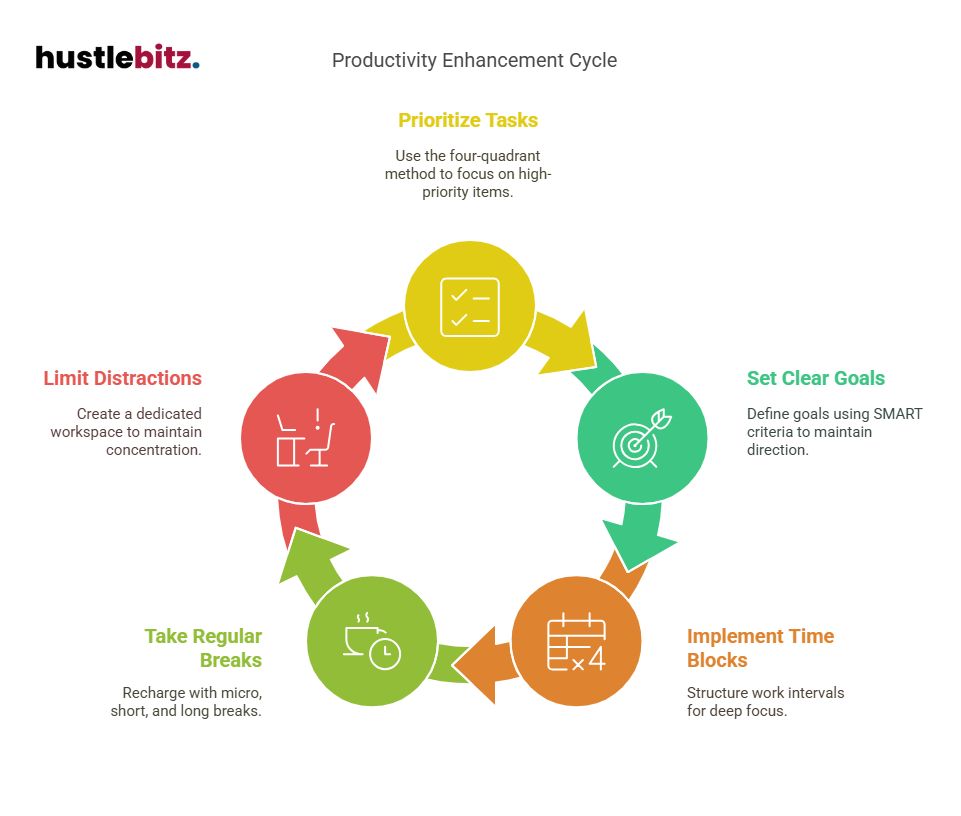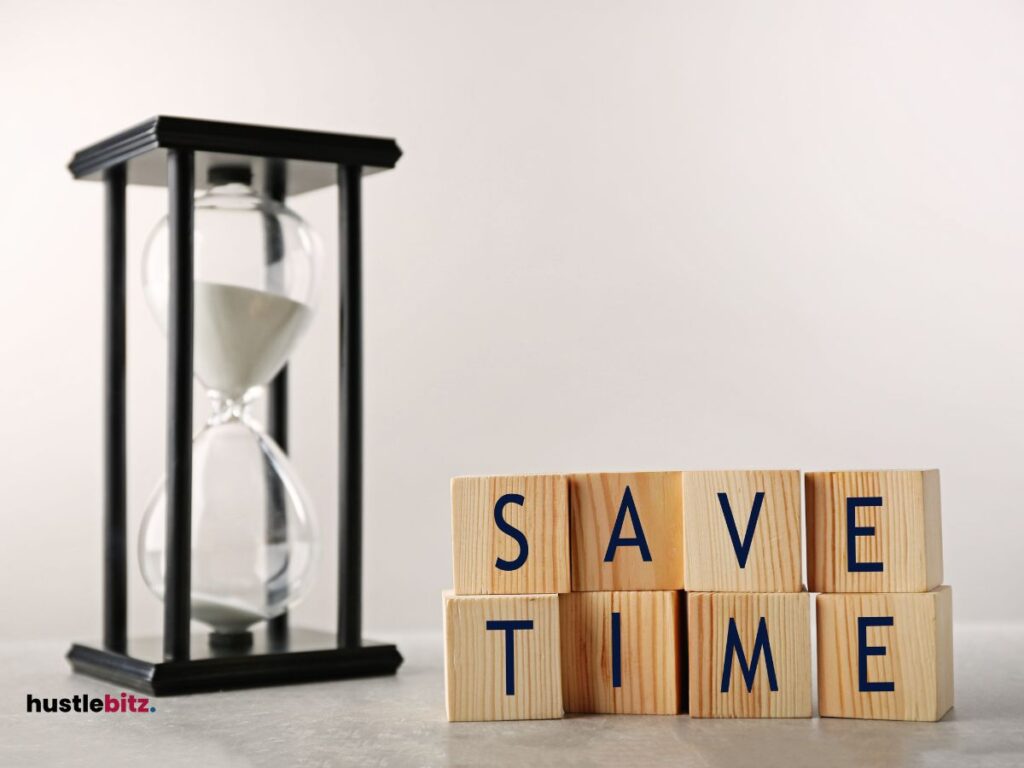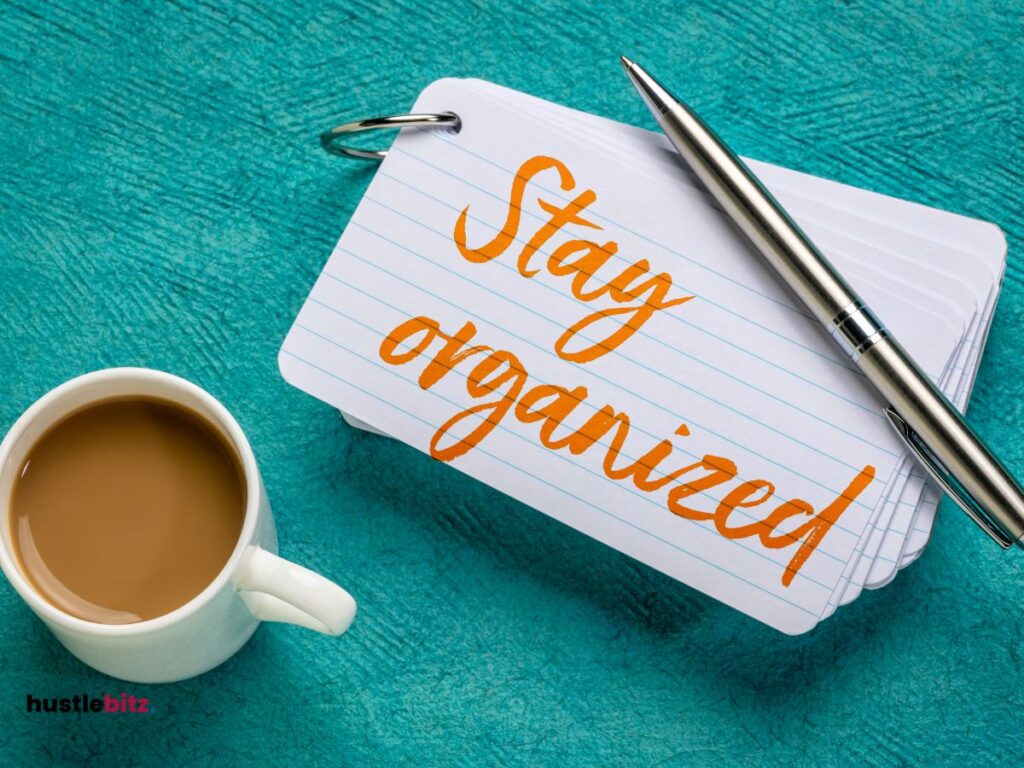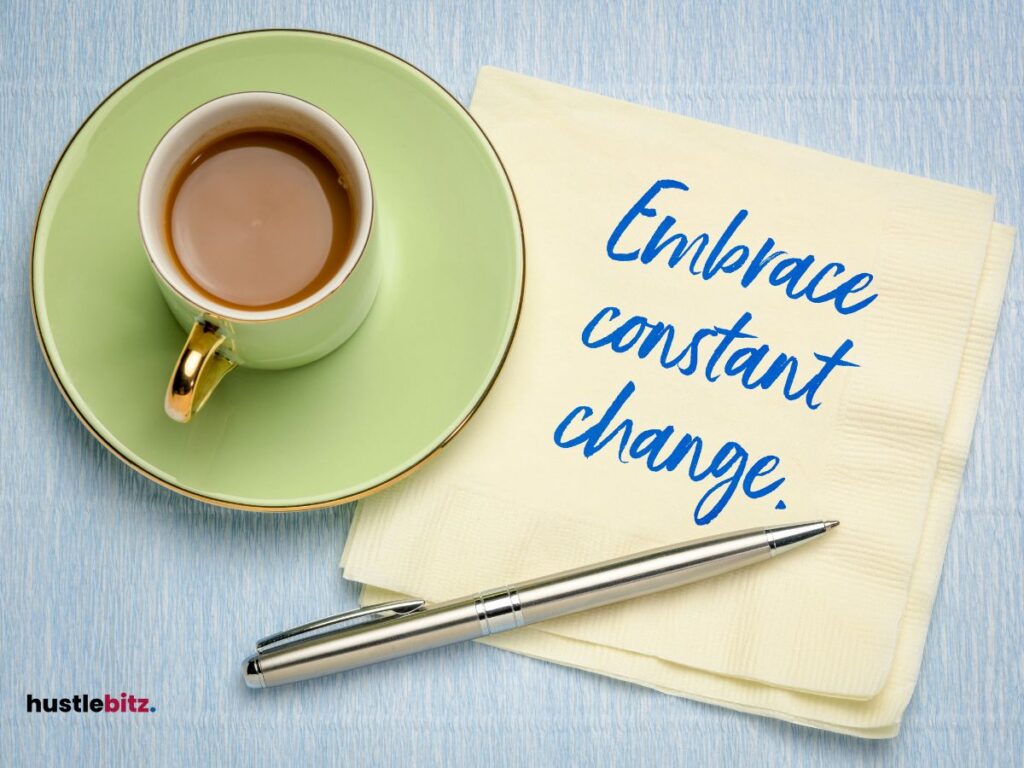Boosting productivity without risking burnout involves prioritizing tasks and setting clear, achievable goals. Regular breaks are essential to recharge and maintain focus. Limit distractions by creating a dedicated workspace and using tools to stay organized. Embrace flexibility in your schedule to align work with your natural energy levels. Incorporating physical activity into your routine can elevate energy and creativity. Foster a healthy work-life balance by setting boundaries and scheduling time for personal interests. Implementing these strategies will help you boost productivity while safeguarding your well-being. Discover additional insights to optimize your productivity further.
Key Takeaways
- Prioritize tasks using the four-quadrant method to distinguish between urgency and importance, focusing on high-priority items.
- Set clear goals using SMART criteria to maintain direction and prevent overwhelm from larger tasks.
- Implement time blocks for structured work intervals, enabling deep focus and efficient energy management.
- Take regular breaks to recharge, including micro, short, and long breaks, for improved focus and productivity.
- Limit distractions by creating a dedicated workspace and using tools like ‘Do Not Disturb’ mode to maintain concentration.

1. Prioritize Your Tasks

Effective productivity starts with the ability to prioritize your tasks based on urgency and importance. This foundational skill is crucial for developing habits that enhance performance and contribute to long-term well-being. By distinguishing between urgent and important tasks, you can better allocate your time and energy, ensuring that critical tasks receive the attention they deserve.
One of the most effective productivity tips is to create a daily or weekly task list. Begin by categorizing tasks into four quadrants: urgent and important, important but not urgent, urgent but not important, and neither urgent nor important. This method helps you visualize your workload and focus on high-priority items aligned with your goals. As you prioritize your tasks, you’ll reduce stress by eliminating the overwhelming feeling of having too much to do without a clear direction.
Furthermore, prioritizing tasks not only enhances productivity but also helps prevent burnout. By focusing on essential activities and delegating or postponing less critical ones, you can maintain a balanced workload. This balance is crucial for sustaining motivation and energy levels over time.
Ultimately, cultivating the habit of prioritization empowers you to manage your time efficiently, leading to both increased productivity and a healthier, more sustainable work-life balance.
2. Take Regular Breaks

Incorporating regular breaks into your work routine is essential for sustaining productivity and preventing burnout. Breaks allow your mind to reset and rejuvenate, enhancing your ability to focus and tackle tasks more effectively. Research indicates that short, frequent breaks during work hours can significantly improve your productivity, helping you maintain a high level of performance throughout the day.
To maximize the benefits of breaks, consider the following strategies:
| Break Type | Duration |
| Micro Break | 1-5 minutes |
| Short Break | 10-15 minutes |
| Long Break | 30-60 minutes |
| Extended Break | 1+ hour |
Micro breaks can be as simple as standing up, stretching, or taking a few deep breaths. Short breaks might involve stepping away from your workspace for a quick walk or a cup of tea. Long breaks, such as a lunch break, provide more time to recharge. Lastly, extended breaks are beneficial for personal reflection or engaging in hobbies, ensuring you return to work refreshed.
3. Set Clear Goals

Setting clear goals is key to enhancing productivity by providing direction and focus, allowing you to prioritize tasks effectively. When you set clear goals, you create a roadmap that guides your daily activities and decisions, helping you avoid distractions and maintain productivity throughout your workday.
To boost your productivity without burnout, it’s important to distinguish between personal and professional goals. Personal goals may relate to well-being, work-life balance, and personal growth, while professional goals should align with your career aspirations and organizational objectives. By setting both types of goals, you create a holistic approach that nurtures overall development.
Use the SMART criteria—Specific, Measurable, Achievable, Relevant, and Time-bound—to set clear goals. This framework not only provides clarity but also allows you to track progress and celebrate achievements, further motivating you to maintain productivity.
Additionally, breaking larger goals into smaller, actionable tasks can help prevent feelings of overwhelm. By focusing on manageable steps, you can create a sense of accomplishment that fuels your motivation. Regularly review and adjust your goals to ensure they remain relevant and achievable.
Ultimately, by setting clear goals, you establish a structured approach that fosters both productivity and well-being, allowing you to pursue your ambitions without succumbing to burnout.
4. Limit Distractions

Achieving clear goals can be undermined by numerous distractions that fragment focus and hinder productivity. To effectively limit distractions, it’s essential to identify their sources and implement strategies that can significantly boost productivity. By creating a conducive work environment and setting boundaries, you can increase your productivity at work while reducing stress levels.
One approach is to identify common distractions and categorize them for better management. The table below highlights typical distractions and corresponding solutions:
| Type of Distraction | Solution |
| Digital Notifications | Use ‘Do Not Disturb’ mode |
| Background Noise | Use noise-canceling headphones |
| Social Media | Set specific times for use |
Implementing these strategies helps you maintain focus and enhance workplace productivity. Establishing a dedicated workspace free from personal interruptions is another vital step. Informing colleagues of your focus times can further limit disruptions. Additionally, scheduling short breaks to recharge can prevent burnout, allowing you to return to tasks with renewed energy and concentration.
5. Foster a Healthy Work-Life Balance

Fostering a healthy work-life balance is essential for maintaining both productivity and overall well-being in today’s fast-paced work environment. As many individuals continue to work from home, the lines between personal and professional life can easily blur, leading to increased stress and burnout. To counter this, it’s crucial to set boundaries that promote a clear separation between work and home life.
One effective strategy is to establish a designated workspace free from distractions. This physical separation can enhance focus, thereby improving productivity in the workplace. Additionally, scheduling regular breaks throughout the day is vital. These breaks allow for mental rejuvenation, which can significantly aid in maintaining productivity. A short walk, a few moments of meditation, or even a quick chat with a colleague can provide the necessary reset to tackle tasks more effectively.
Moreover, prioritizing personal time is equally important. Engaging in hobbies, exercising, or spending quality time with family and friends can help reduce stress levels and enhance overall life satisfaction. When individuals foster a healthy work-life balance, they are not only more productive but also more engaged and motivated in their roles.
Ultimately, achieving this balance is a continuous process that requires self-awareness and intentionality. By implementing these strategies, individuals can create a sustainable work environment that promotes both productivity and well-being, ensuring they do not burn out while striving for success.
6. Use Time Blocks

Implementing time blocks can significantly enhance productivity by providing structured periods dedicated to specific tasks or projects. This method allows individuals to segment their workday into focused intervals, which can lead to higher productivity levels and reduced feelings of overwhelm. By allocating specific time slots for various tasks, you can create a clear roadmap for your work, ultimately helping to boost your productivity.
Time blocks encourage a disciplined approach to managing your time and energy. For instance, dedicating 90-minute blocks to deep work can facilitate immersion in complex projects, while shorter blocks can be reserved for less demanding tasks such as emails or meetings. This structured approach not only helps maintain focus but also provides built-in breaks, which are essential for preventing burnout.
Moreover, using time blocks allows you to prioritize tasks more effectively. By assessing which activities require immediate attention, you can allocate your time accordingly, ensuring that high-priority tasks receive the focus they deserve. This method also fosters a sense of accomplishment as you complete each block, further motivating you to stay on track throughout the workday.
Incorporating time blocks into your routine can lead to a healthier relationship with work. By minimizing distractions and fostering a sense of control over your schedule, you can maintain higher productivity levels while safeguarding your well-being. Ultimately, this practice serves as an effective strategy to boost productivity without succumbing to the pressures that often lead to burnout.
7. Stay Organized

Staying organized is crucial for maintaining productivity and reducing stress in both personal and professional environments. When you create an organized space, you foster a mindset that is conducive to focus and efficiency. This, in turn, leads to enhanced productivity at work and in daily tasks. Here are some simple ways to boost your productivity by staying organized:
| Organizational Method | Benefits |
| Use Task Lists | Prioritizes tasks effectively |
| Declutter Regularly | Reduces distractions |
| Set Clear Deadlines | Encourages accountability |
Implementing these strategies helps you increase your work productivity significantly. For instance, utilizing task lists enables you to visualize your workload, ensuring that essential tasks are prioritized. This not only provides clarity but also promotes a sense of accomplishment as you check off completed items.
Regular decluttering of your workspace is another effective way to stay organized. A tidy environment minimizes distractions and enhances your ability to concentrate on the task at hand. Furthermore, setting clear deadlines for projects creates urgency and helps you manage your time efficiently.
Incorporating these organizational methods into your routine is one of the most effective ways to boost productivity. By fostering an organized environment, you can eliminate chaos and improve focus, ultimately leading to better performance and a healthier work-life balance.
8. Embrace Flexibility

An organized approach to work can set the stage for embracing flexibility, allowing you to adapt to changing circumstances while maintaining productivity.
Embracing flexibility is vital in today’s fast-paced environment, where unexpected challenges can disrupt even the best-laid plans. By cultivating a mindset that values adaptability, you can discover innovative ways to boost productivity without sacrificing your well-being.
One effective way to become more productive is to adjust your work time based on your energy levels. Instead of adhering strictly to a conventional schedule, identify when you are most alert and focused, and allocate your most demanding tasks to those peak periods. This not only enhances the quality of your work but also minimizes stress as you align your responsibilities with your natural rhythms.
Additionally, consider incorporating shorter work intervals followed by brief breaks. This technique, often referred to as the Pomodoro Technique, allows for bursts of concentrated effort followed by restorative pauses. Such a method can lead to heightened focus and creativity, further contributing to your ability to embrace flexibility.
Lastly, when challenges arise, take a moment to reassess your priorities. Being open to adjusting deadlines or shifting tasks can alleviate pressure and provide opportunities for more efficient work patterns. By welcoming flexibility, you cultivate a work environment that fosters resilience, ultimately leading to less stress and a more balanced approach to productivity.
9. Optimize Your Workspace for Comfort and Focus
Creating a workspace that prioritizes comfort and focus is essential for enhancing productivity and minimizing distractions. A well-optimized workspace can significantly impact your ability to stay focused throughout the workday and ultimately boost creativity. To achieve this, consider several key elements that contribute to an effective working environment.
First, invest in ergonomic furniture, such as a comfortable chair and a height-adjustable desk. These items promote better posture and reduce physical strain, allowing you to concentrate on your tasks without discomfort. Additionally, decluttering your desk can help minimize distractions, enabling you to focus on the essential work at hand.
Lighting plays a crucial role in optimizing your workspace. Natural light is ideal, as it not only brightens your environment but also enhances mood and alertness. If natural light is limited, opt for soft, adjustable artificial lighting that can reduce eye strain.
Incorporating personal touches, like plants or artwork, can further boost creativity. These elements provide a sense of ownership over your space and create a more inviting atmosphere.
10. Incorporate Physical Activity to Enhance Energy Levels
Incorporating regular physical activity into your daily routine can significantly enhance energy levels and overall productivity. Engaging in even short bouts of exercise can stimulate the release of endorphins, which are essential for improving mood and focus. This physiological boost can lead to heightened concentration and a more proactive approach to tasks, ultimately enhancing productivity.
There are various ways to boost your energy through physical activity. For instance, consider integrating short walks or stretching sessions into your workday. These brief intervals can invigorate your mind, break the monotony of long sitting periods, and provide a much-needed mental reset.
Moreover, activities like yoga or tai chi not only foster physical well-being but also promote mindfulness, further sharpening focus.
It’s important to find an exercise routine that resonates with you. Whether you prefer high-intensity workouts or leisurely activities like cycling or gardening, the key is to incorporate physical activity consistently. This regular engagement not only enhances energy levels but also contributes to overall health, reducing the risk of burnout.
Final Thoughts
Boosting productivity without falling into the trap of burnout is all about balance. By prioritizing tasks, setting clear goals, taking regular breaks, and managing distractions, you can maintain high levels of productivity without compromising your well-being. Embracing flexibility, staying organized, and optimizing your workspace further enhance your ability to stay focused and efficient. Incorporating physical activity into your routine not only improves your energy levels but also supports overall mental and physical health. By integrating these strategies into your daily life, you can achieve sustained productivity while preserving your work-life balance and personal fulfillment.




